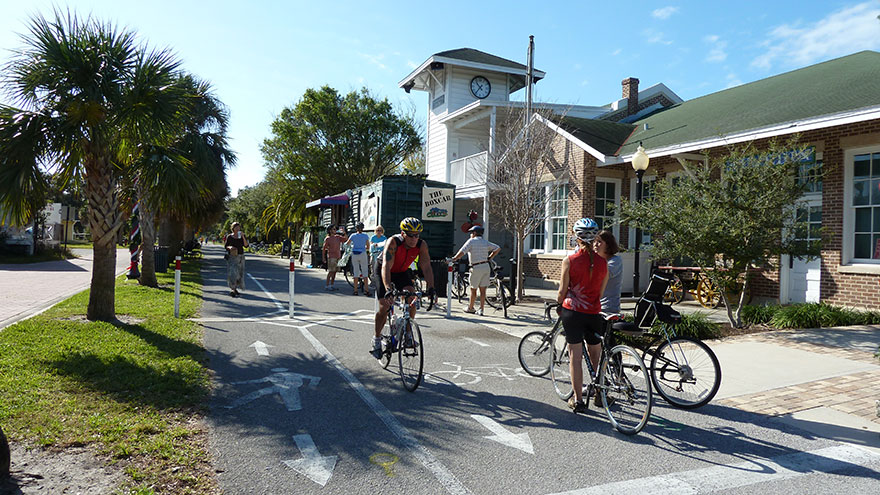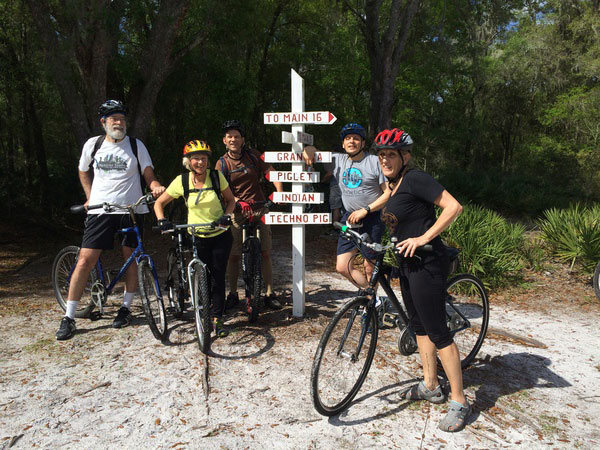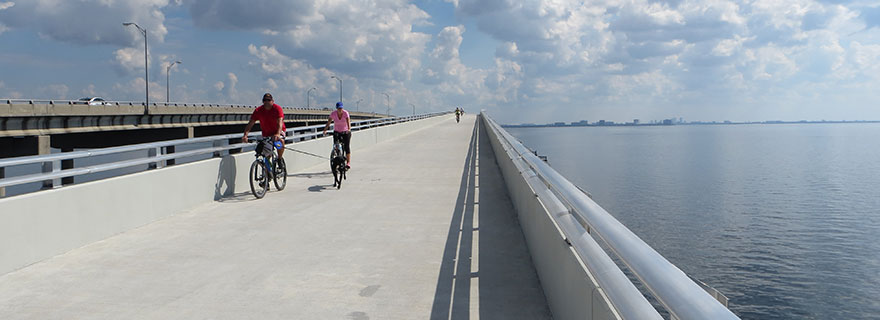Explore the various habitats and view wildlife around Tampa Bay on these top-rated bicycle trails
By Marcia Biggs
With the opening of the Pinellas section of the Courtney Campbell Trail last summer, the Tampa Bay area is rapidly becoming a destination for cycling enthusiasts. The long-awaited 9.5-mile span offers the exceptional experience of crossing Upper Tampa Bay on a safe, stand-alone trail affording spectacular views along the way.
A jointly funded project between the Florida Department of Transportation and Hillsborough and Pinellas counties, the Courtney Campbell Trail is more than just a new bike trail. It’s also an important link in the regional Greenways and Trails initiative which aims to provide a network of linked trails for recreation and transportation across the region. It’s the newest in a series of bicycle trails around Tampa Bay providing scenic beauty and wildlife viewing opportunities. There’s a ride for everyone from easy paved “rails to trails” rides like the Pinellas Trail and Upper Tampa Bay Trail to the butt-kicking off-road trails of Alafia River State Park.
I ride nearly every weekend on both paved and off-road trails. The best are scattered throughout Hillsborough and Pinellas counties, except for the Withlacoochee State Trail, the state’s longest rails-to-trails project, so I’ll be focusing on these. And a word to the wise: Consider recent rainfall before heading out on any trail. Winter is generally a dry season and ideal for cycling, but a heavy downpour can leave low-lying paved and dirt trails underwater. Try calling the county parks department before heading out if you have any doubts about conditions.
Courtney Campbell Trail
The Courtney Campbell Trail offers a beautiful ride across Tampa Bay with the added bonus of being part of the Great Florida Birding Trail. Diverse species of birds gravitate here for feeding along the sand and rock shoreline, particularly at low tide. It is common to spot flocks of terns, oystercatchers, sandpipers and plovers, dowitchers, skimmers, gulls, roseate spoonbills, white ibis, herons, brown and white pelicans and many other wading and migrating birds on your ride. (A recent visit to ebird.org revealed 105 species sighted here!)
This wide, paved path spans the entire south side of the causeway from the Veterans Expressway in Tampa to Bayshore Boulevard in Clearwater. Take caution since you will be sharing this trail with walkers and rollerbladers who come here to enjoy the pleasant breezes and colorful sunsets. (Fishermen are only allowed on the north side of the causeway and under the bridge, so you won’t be dodging fishing lines.)
A connecting trail extends to Cypress Point Park on the east end and a new link is set to open this summer along Bayshore Boulevard on the west end and into Safety Harbor. In the meantime, cyclists can still ride into Safety Harbor on the sidewalk along the west side of Bayshore. You also have the option to head west on the Ream Wilson Trail for a very pleasant, shady 5-mile ride to the Long Recreation Center.
The downside of riding beside the Courtney Campbell Causeway is that more than 50,000 cars per day traverse this six-lane state highway, so it can be noisy during high-traffic times. But the amazing views seem to make the cars whizzing by just fade into the background. For a fun excursion, plan a day trip that includes a ride into Safety Harbor for lunch and a visit to the fishing pier.
Public parking lots are located at the east end of the trail near Ben T. Davis Beach and at the causeway boat ramp. Be aware there are no restrooms or water along this trail.
Upper Tampa Bay Trail
This wide, shady trail (a personal favorite) winds through 7.25 miles of greenway, along the west shore of Channel A, and traverses a segment of the former Citrus Park rail corridor. You’ll also catch glimpses of meandering Rocky Creek and a variety of birdlife. It’s worth stopping to read the interesting signage along the trail that describes how the channel came into existence (built for flood control in the 1960s), the history of the railway line (hauling timber from Tarpon Springs) and points out landmarks like the closed county landfill (yes, it’s that large grass-covered hill).
Upper Tampa Bay Trail (UTBT) is impeccably maintained by Hillsborough County, with frequent water stops, picnic tables and benches along the way. Watch out for the walkers and runners who enjoy this lovely trail as much as bike riders. A main trailhead on Waters Avenue offers restroom facilities and a large parking lot (with a $2 fee to park); a smaller lot is free at the southern trailhead.
Last summer, a 4.3-mile trail segment opened from Lutz-Lake Fern Road which runs through Brooker Creek Headwaters Preserve to Van Dyke Road. With three concrete boardwalks through wetlands and pine flatwoods, this is the county’s first paved multi-use trail through a preserve. In reality, it’s more an extension of the southern end of the Suncoast Trail. A gap in the UTBT remains between Peterson Road Park and Van Dyke Road; officials are working with property owners to gain access, but so far it’s been slow going. When the gap closes, the completed UTBT will connect with the 42-mile Suncoast Trail through Pasco and into Hernando County.
Suncoast Trail
Part of Florida’s Greenways and Trails system, the paved Suncoast Trail is busy on weekends with both recreational riders and packs of spandex-clad speed demons in training. If you drive along the Suncoast Parkway, you’re likely to spot bikers along the west side as they zip north or south on the trail. I like to park near the trailhead at State Road 54 and head north to J.B. Starkey Wilderness Park. Here I enjoy the ride through the park on the paved 7.3-mile trail (look for the wild turkeys). If you’re up for the challenge, there are seven miles of mountain bike trails. If you want a longer ride, start at the new trailhead on Lutz Lake Fern Road. Both the Suncoast and Starkey Park trails are not well shaded, so be prepared.
Fred Marquis Pinellas Trail

A hands-down favorite for its diversity, length and accessibility, the Pinellas Trail ranks as one of the premier urban bike trails in Florida, if not the country. The 37-mile paved trail extends from Tarpon Springs to downtown St. Petersburg. Most of the trail is built on an abandoned CSX railroad right of way as part of the national Rails to Trails program. The trail traverses or connects to numerous parks, wooded areas, waterways and coastal areas, backyards and downtowns, offering riders an up-close encounter with both rural and urban communities of Pinellas County.
The segment between Dunedin and Tarpon Springs is a favorite for many cyclists – it’s a pleasant, mostly shady 12-mile ride with lots of places to stop. I like to start at the old train depot on Main Street in downtown Dunedin (now the Dunedin History Museum), and ride north to the Tarpon Springs Sponge Docks for lunch. Look for the Pinellas Reclaimed Water Facility on the east side of the trail; birds love to hang out here, particularly during migration seasons. Hammock Park in north Dunedin is also worth exploring if you have time.
I always stop at Wall Springs Park, one of the hidden gems in the Pinellas County park system. Located trailside in Palm Harbor, this 210-acre park is on the site of an historic spring used as a public spa and bathing area from the turn of the 20th century until the mid-1960s. Take a stroll along the boardwalks and nature trails; this is a great place to spot gopher tortoises, snakes, raccoons, ospreys, eagles and owls. A 35-foot observation tower which was destroyed by arson has been rebuilt, but waiting on final permits so is still inaccessible. Once it’s open, be sure to march to the top for outstanding views of the surrounding pine forest, tidal marsh and Boggy Bayou.
In 2014, a 3-mile extension opened along Keystone Road to East Lake Road, where riders can connect to John Chesnut Park on Lake Tarpon. This 255-acre county park is renowned for its wildlife viewing opportunities.
There is also a spur from the Pinellas Trail west along Curlew Road that leads directly over the Dunedin Causeway to Honeymoon Island State Park.
A number of bicycle shops near the trail offer rentals, check out their website.
Withlacoochee State Trail
The state’s longest rails-to-trails ride is the beautiful Withlacoochee State Trail, a 46-mile stretch of wide, paved track that meanders through small towns amid the Withlacoochee State Forest. This popular trail is straight and flat, making it an easy ride for beginners. The Ridge Manor trailhead in Hernando County with its large parking area and restroom facilities is a good starting point. The north end of the trail is in Citrus Springs, south of Dunnellon. Bike rental shops can be found at most towns along the route such as Inverness and Floral City, which also make great stops for lunch and stretching your legs.
Off-road trails offer adventure
Flatwoods Park and Wilderness Regional Park, Thonotosassa

Some 16,000 acres of magnificent natural Florida encompasses the Lower Hillsborough Wilderness Preserve in northeast Hillsborough County. Two properties owned by the Southwest Florida Water Management District and managed by Hillsborough County offer excellent bicycle trails. Just south of New Tampa, Flatwoods Park has a 7-mile paved loop road in the Morris Bridge well field area and several miles of shady off-road trails. Two trailheads with a large parking area ($2 parking fee) and connecting trails make this a good choice for those who wish to continue their ride south to the Wilderness Park Trail System. Here, single-track mountain bike trails twist and turn through a shady canopy of cypress swamp, hardwood forest, upland hardwood hammocks, pine flatwoods, oak scrub, and prairies in a 1,500-acre playground. Close to 30 miles of mountain bike trails of various levels traverse the Trout Creek, Morris Bridge and Flatwoods areas. A 14-mile Wilderness Loop trail connects all three parks.
Balm Boyette Scrub Preserve, Lithia
Acquired by Hillsborough County in 1992 through its ELAPP program, Balm Boyette Scrub Preserve has 18 miles of trails through nearly 5,000 acres of sand pine scrub, pine flatwoods, oak hammocks, creeks, cypress swamp and freshwater marshes for your off-road biking pleasure. Many protected species of plants and animals have been documented on the preserve, including Florida golden aster, Eastern indigo snake, Sherman’s fox squirrel, sandhill crane, American kestrel, and gopher tortoise. The east end of the preserve includes a 1,200-acre reclaimed phosphate mining area that has been beautifully restored with numerous lakes. Trails range from easy to technical. Look for two trailheads along Balm-Boyette Road.
Alafia River State Park, Lithia
Alafia River State Park is home to some of the most challenging off-road trails in Florida. The former phosphate mining property has been reclaimed by nature and is now 6,300 acres of rugged terrain with many small lakes, sandy hills and drop-offs, and 20 miles of bike trails. There are several easier trails for beginners and intermediates. When you’re done riding, look up to search for a great variety of birds that inhabit the state park. Park entrance fee is $5 per vehicle. Mountain bike trails at Alafia River State Park are marked and maintained by the SWAMP Club, a local mountain biking club that also maintains Balm Boyette and Wilderness Park trails. The club holds monthly guided bike rides and has an informative web site with updated information, directions and maps for each trail; go to swampclub.org.
